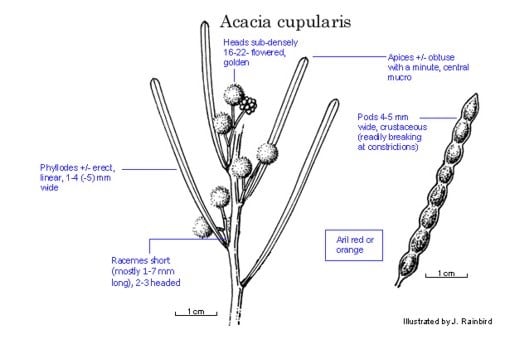Acacia cupularis Domin
WATTLE
Acacias of Australia
Common Name
Coastal Umbrella Bush
Family
Fabaceae
Distribution
Widespread in coastal and near coastal areas of southern Australia from Albany, W.A., through S.A. to the Vic. border, extending inland to Dimboola, western Vic. and Three Springs, W.A.
Description
Open to subdense shrub usually 1–2.5 m high, to 2.5 m wide, glabrous. Branchlets commonly dark red-brown, often lightly pruinose. Phyllodes subdistant, ascending to erect, narrowly linear, straight, 3–8 (–9) cm long, 1–4 (–5) mm wide, rounded-obtuse, with minute and ±central mucro, ±thick, finely wrinkled when dry, subglaucous to dark green; midrib not prominent; glands 2 or 3, with lowermost 3–14 mm above pulvinus, and distal glands smaller with one at base of mucro. Inflorescences 2 or 3-headed racemes; raceme axes 1–7 (–9) mm long; basal bracts caducous but bract scars persistent; peduncles 2–6 mm long; heads globular, subdense, 16–22-flowered, golden. Flowers 5-merous; sepals united into a ±truncate calyx. Pods ±erect, ±submoniliform, to 7 cm long, 4–5 mm wide, crustaceous, breaking readily at constrictions, commonly dark brown. Seeds longitudinal, oblong, 3–5 mm long, dull, light brown; aril orange to scarlet.
Habitat
Grows in sand, sometimes on dunes, or in loam or sandy clay in mallee communities.
Specimens
W.A.: Esperance, 1.6–3.2 km from ocean, B.R.Maslin 2544a (CANB, K, MEL, PERTH); 33 km from Morawa towards Three Springs, B.R.Maslin 4275 (AD, CANB, PERTH). S.A.: 3.5 km E of S.A.–W.A. State Border, R.J.Chinnock 3347 (AD, PERTH); Hincks Natl Park, D.Symon 6513 (AD). Vic.: Little Desert, S of Kaniva, A.C.Beauglehole 18916 (MEL).
Notes
Acacia cupularis is a member of the ‘A. bivenosa group’ and until recently was considered conspecific with A. ligulata (fide A.R.Chapman & B.R.Maslin, Nuytsia 8: 260 (1992)). Narrow phyllode forms of A. ligulata are most reliably distinguished from A. cupularis by wider, woody pods which don’t break readily at constrictions between the seeds and phyllodes which are thicker (therefore ±coarsely wrinkled when dry) and uncinate with a recurved to straight mucro. Phyllodes may resemble those of A. maxwellii which differs in having pubescent branchlets and longer peduncles. Acacia maxwellii is also a prostrate shrub, while A. cupularis is normally erect, however a prostrate form of the latter is known from coastal cliffs in S.A. Superficially similar to A. crassiuscula and A. anceps × nematophylla.
FOA Reference
Data derived from Flora of Australia Volumes 11A (2001), 11B (2001) and 12 (1998), products of ABRS, ©Commonwealth of Australia
Author
A.R.Chapman, B.R.Maslin
Minor edits by B.R.Maslin & J.Rogers
This identification key and fact sheets are available as a mobile application:
URL: https://apps.lucidcentral.org/wattle/
© Copyright 2018. All rights reserved.










